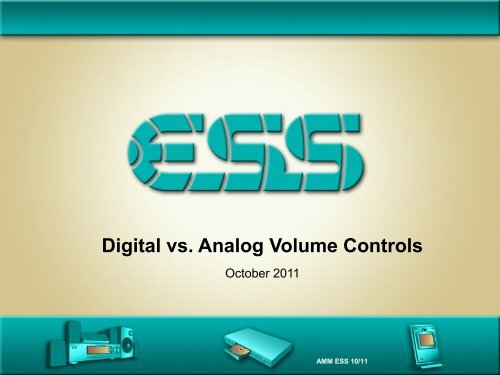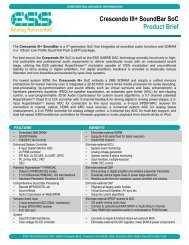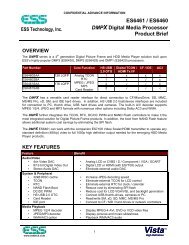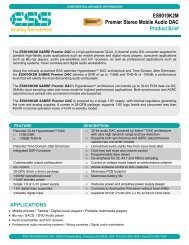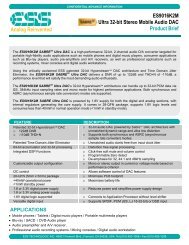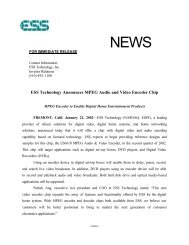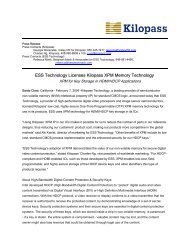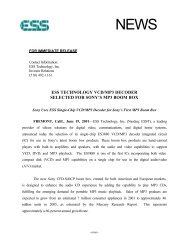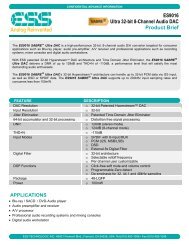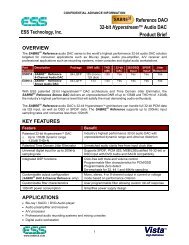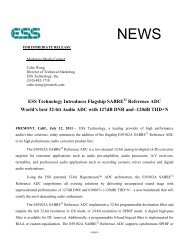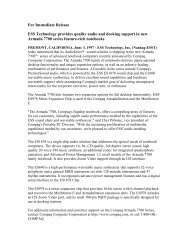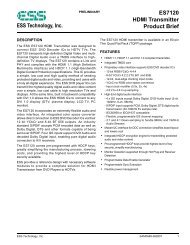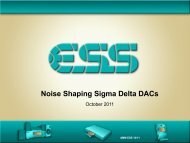Digital/Analog Volume Control
Digital/Analog Volume Control
Digital/Analog Volume Control
Create successful ePaper yourself
Turn your PDF publications into a flip-book with our unique Google optimized e-Paper software.
<strong>Digital</strong> vs. <strong>Analog</strong> <strong>Volume</strong> <strong>Control</strong>s<br />
October 2011<br />
AMM ESS 10/11
Summary of this Presentation<br />
• In a <strong>Digital</strong> Audio System what is the trade-off<br />
between using a digital or an analog volume<br />
control?<br />
– To answer this question we need to know:<br />
• How a digital volume control works and<br />
what are its limitations<br />
• How an analog volume control works and<br />
what are its limitations<br />
D vs A <strong>Volume</strong> 2 of 39
<strong>Digital</strong> <strong>Volume</strong> <strong>Control</strong> -10dB<br />
• Here is the number 30,003 shown as it appears to a 16 bit DAC:<br />
0111010100110011 = 30,003<br />
• How do we “turn its volume down” - ie reduce its amplitude?<br />
We simply multiply it by say -10dB<br />
-10db is 0.3162 and here is the result:<br />
0010010100010000 = 9,488<br />
• Any problem? Shouldn’t the answer actually have been<br />
30,003 * 0.3162 = 9487.7817?<br />
Its close, it is only wrong by 23 parts per million, but it is not right<br />
D vs A <strong>Volume</strong> 3 of 39
<strong>Digital</strong> <strong>Volume</strong> <strong>Control</strong> -35dB<br />
• Here is the number 30,003 shown as it appears to a 16 bit DAC:<br />
0111010100110011 = 30,003<br />
• How do we “turn its volume down even more”, say by -35dB<br />
-35db is 0.0177828 and here is the result:<br />
0000001000010110 = 534<br />
• Any problem? Shouldn’t the answer actually have been<br />
30,003 * 0.3162 = 533.5372?<br />
Its close, but not so close, it is wrong by 866 parts per million<br />
D vs A <strong>Volume</strong> 4 of 39
866ppm – surely no problem?<br />
• Why worry about 23ppm at -10dB, and 866ppm at -35db?<br />
Surely these are small errors?<br />
• No they are not small:<br />
– 866ppm has degraded the performance of that 16 bit DAC by a<br />
factor of more than 50!<br />
• ►As a digital volume control operates on a fixed-width field (ie on<br />
that 16 bit number that the DAC receives) it creates noise because<br />
the DAC cannot make the fractional part of the number.<br />
– And this is a large noise!<br />
D vs A <strong>Volume</strong> 5 of 39
<strong>Digital</strong> (Frequency Domain) -1dB<br />
We will learn more if we are prepared to look at signals in the<br />
Frequency Domain. Here is a 16bit DAC in time and in frequency:<br />
D vs A <strong>Volume</strong> 6 of 39<br />
ENOB 15.87<br />
SN 97.63<br />
The amplitude<br />
here is -1dB
<strong>Digital</strong> (Frequency Domain) -10dB<br />
We will learn more if we are prepared to look at signals in the<br />
Frequency Domain. Here is a 16bit DAC in time and in frequency:<br />
D vs A <strong>Volume</strong> 7 of 39<br />
ENOB 14.35<br />
SN 88.51<br />
The amplitude<br />
here is -10dB
<strong>Digital</strong> (Frequency Domain) -35dB<br />
We will learn more if we are prepared to look at signals in the<br />
Frequency Domain. Here is a 16bit DAC in time and in frequency:<br />
D vs A <strong>Volume</strong> 8 of 39<br />
ENOB 10.17<br />
SN 63.18<br />
The amplitude<br />
here is -35dB
<strong>Digital</strong> <strong>Volume</strong> <strong>Control</strong> – fixed noise<br />
Clearly, the noise is not moving!<br />
D vs A <strong>Volume</strong> 9 of 39<br />
The signal is<br />
decreasing as<br />
we requested<br />
But the noise is<br />
not going<br />
down!<br />
Consequently, the<br />
signal-to-noise ratio<br />
is getting worse as<br />
digital volume<br />
control is reduced<br />
This is why audiophiles generally avoid digital volume control
<strong>Analog</strong> (Frequency Domain) -1dB<br />
We will learn more if we are prepared to look at signals in the<br />
Frequency Domain. Here is a 16bit DAC in time and in frequency:<br />
D vs A <strong>Volume</strong> 10 of 39<br />
ENOB 16.01<br />
SN 98.53<br />
The amplitude<br />
here is -1dB
<strong>Analog</strong> (Frequency Domain) -10dB<br />
We will learn more if we are prepared to look at signals in the<br />
Frequency Domain. Here is a 16bit DAC in time and in frequency:<br />
D vs A <strong>Volume</strong> 11 of 39<br />
ENOB 15.94<br />
SN 97.95<br />
The amplitude<br />
here is -10dB
<strong>Analog</strong> (Frequency Domain) -35dB<br />
We will learn more if we are prepared to look at signals in the<br />
Frequency Domain. Here is a 16bit DAC in time and in frequency:<br />
D vs A <strong>Volume</strong> 12 of 39<br />
ENOB 14.94<br />
SN 91.8<br />
The amplitude<br />
here is -35dB
<strong>Analog</strong> <strong>Volume</strong> - variable noise<br />
Now the noise moves down as well<br />
D vs A <strong>Volume</strong> 13 of 39<br />
The signal is<br />
decreasing as<br />
we requested<br />
Now the noise<br />
is going down<br />
as well<br />
The signal to noise<br />
ratio is being<br />
maintained<br />
This is why audiophiles generally like analog volume control
Can <strong>Digital</strong> be Improved?<br />
• <strong>Analog</strong> appears to be a clear winner.<br />
But can we improve digital?<br />
– The digital volume control is limited because the DAC (and the<br />
data source in the last example) were both 16bits.<br />
– What happens when a 16 bit number is fed to a 32 bit DAC?<br />
Internally 32 bits,<br />
externally 16/24<br />
D vs A <strong>Volume</strong> 14 of 39
<strong>Volume</strong> <strong>Control</strong> internal to DAC<br />
• Here is the number 30,003 shown as it appears to a 32 bit DAC:<br />
0111010100110011.0000000000000000 = 30,003<br />
• How do we “turn its volume down even more”, say by -35dB<br />
-35db is 0.0177828 and here is the result:<br />
0000001000010110.1000100110000100 = 533.5372<br />
• Any problem? Shouldn’t the answer actually have been<br />
30,003 * 0.3162 = 533.5372?<br />
As indeed it is...<br />
When the volume control has<br />
access to the additional bits in<br />
the DAC data path, there is no<br />
numerical loss of accuracy<br />
D vs A <strong>Volume</strong> 15 of 39
Optimum <strong>Digital</strong> <strong>Volume</strong> <strong>Control</strong><br />
• A <strong>Digital</strong><br />
volume<br />
control<br />
with access<br />
to the DAC<br />
internal data<br />
path will<br />
behave just<br />
like the analog one until it<br />
reaches the noise floor<br />
of the analog components<br />
of the DAC.<br />
• -135dB in the ESS Sabre DAC<br />
And the noise<br />
will fall as well<br />
until the DAC<br />
noise floor is<br />
reached<br />
The signal is<br />
decreasing as we<br />
requested<br />
D vs A <strong>Volume</strong> 16 of 39
<strong>Analog</strong> still better?<br />
• In fact, yes it is.<br />
– As long as the analog volume control has a noise floor better<br />
than the DAC noise floor, the analog one will win<br />
• Conclusion:<br />
– <strong>Analog</strong> volume controls easily outperform digital, unless the<br />
digital control has access to the data path of the DAC<br />
(ie is internal to the DAC)<br />
– Exquisitely well designed analog volume controls can still beat<br />
even the very best internal digital volume controls if they have a<br />
lower noise floor than the DAC itself<br />
• The -135dB of the ESS Sabre DAC would need an exceptionally<br />
low noise analog volume control to beat its internal digital one<br />
D vs A <strong>Volume</strong> 17 of 39
End of <strong>Volume</strong> <strong>Control</strong> Presentation<br />
Any questions?<br />
D vs A <strong>Volume</strong> 18 of 39


